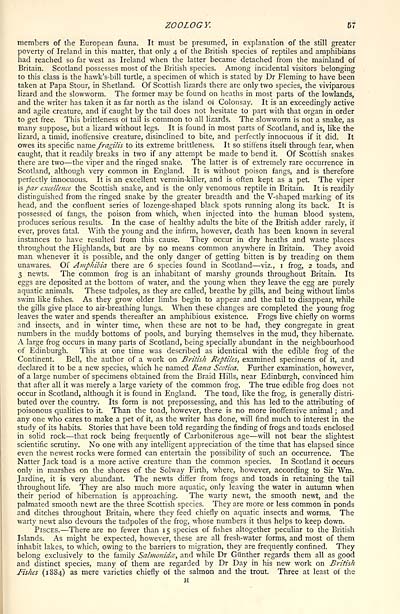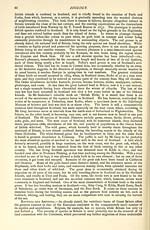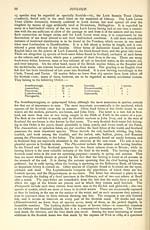Ordnance gazetteer of Scotland > Volume 6
(385) Page 57
Download files
Complete book:
Individual page:
Thumbnail gallery: Grid view | List view

ZOOLOGY. 67
members of the European fauna. It must be presumed, in explanation of the still greater
poverty of Ireland in this matter, that only 4 of the British species of reptiles and amphibians
had reached so far west as Ireland when the latter became detached from the mainland of
Britain. Scotland possesses most of the British species. Among incidental visitors belonging
to this class is the hawk's-bill turtle, a specimen of which is stated by Dr Fleming to have been
taken at Papa Stour, in Shetland. Of Scottish lizards there are only two species, the viviparous
lizard and the slowworm. The former may be found on heaths in most parts of the lowlands,
and the writer has taken it as far north as the island oi Colon say. It is an exceedingly active
and agile creature, and if caught by the tail does not hesitate to part with that organ in order
to get free. This brittleness of tail is common to all lizards. The slowworm is not a snake, as
many suppose, but a lizard without legs. It is found in most parts of Scotland, and is, like the
lizard, a timid, inoffensive creature, disinclined to bite, and perfectly innocuous if it did. It
owes its specific name fragilis to its extreme brittleness. It so stiffens itself through fear, when
caught, that it readily breaks in two if any attempt be made to bend it. Of Scottish snakes
there are two — the viper and the ringed snake. The latter is of extremely rare occurrence in
Scotland, although very common in England. It is without poison fangs, and is therefore
perfectly innocuous. It is an excellent vermin-killer, and is often kept as a pet. The viper
is par excelloice the Scottish snake, and is the only venomous reptile in Britain. It is readily
distinguished from the ringed snake by the greater breadth and the V-shaped marking of its
head, and the confluent series of lozenge-shaped black spots running along its back. It is
possessed of fangs, the poison from which, when injected into the human blood system,
produces serious results. In the case of healthy adults the bite of the British adder rarely, if
ever, proves fatal. With the young and the infirm, however, death has been known in several
instances to have resulted from this cause. They occur in dry heaths and waste places
throughout the Highlands, but are by no means common anywhere in Britain. They avoid
man whenever it is possible, and the only danger of getting bitten is by treading on them
unawares. Of Amphibia there are 6 species found in Scotland — viz., 1 frog, 2 toads, and
3 newts. The common frog is an inhabitant of marshy grounds throughout Britain. Its
eggs are deposited at the bottom of water, and the young when they leave the egg are purely
aquatic animals. These tadpoles, as they are called, breathe by gills, and being without limbs
swim like fishes. As they grow older limbs begin to appear and the tail to disappear, while
the gills give place to air-breathing lungs. When these changes are completed the young frog
leaves the water and spends thereafter an amphibious existence. Frogs live chiefly on worms
and insects, and in winter time, when these are not to be had, they congregate in great
numbers in the muddy bottoms of pools, and burying themselves in the mud, they hibernate.
A large frog occurs in many parts of Scotland, being specially abundant in the neighbourhood
of Edinburgh. This at one time was described as identical with the edible frog of the
Continent. Bell, the author of a work on British Reptiles, examined specimens of it, and
declared it to be a new species, which he named Rana Scotica. Further examination, however,
of a large number of specimens obtained from the Braid Hills, near Edinburgh, convinced him
that after all it was merely a large variety of the common frog. The true edible frog does not
occur in Scotland, although it is found in England. The toad, like the frog, is generally distri-
buted over the country. Its form is not prepossessing, and this has led to the attributing of
poisonous qualities to it. Than the toad, however, there is no more inoffensive animal ; and
any one who cares to make a pet of it, as the writer has done, will find much to interest in the
study of its habits. Stories that have been told regarding the finding of frogs and toads enclosed
in solid rock — -that rock being frequently of Carboniferous age — will not bear the slightest
scientific scrutiny. No one with any intelligent appreciation of the time that has elapsed since
even the newest rocks were formed can entertain the possibility of such an occurrence. The
Natter Jack toad is a more active creature than the common species. In Scotland it occurs
only in marshes on the shores of the Solway Firth, where, however, according to Sir Wm.
Jardine, it is very abundant. The newts differ from frogs and toads in retaining the tail
throughout life. They are also much more aquatic, only leaving the water in autumn when
their period of hibernation is approaching. The warty newt, the smooth newt, and the
palmated smooth newt are the three Scottish species. They are more or less common in ponds
and ditches throughout Britain, where they feed chiefly on aquatic insects and worms. The
warty newt also devours the tadpoles of the frog, whose numbers it thus helps to keep down.
Pisces. — There are no fewer than 15 species of fishes altogether peculiar to the British
Islands. As might be expected, however, these are all fresh-water forms, and most of them
inhabit lakes, to which, owing to the barriers to migration, they are frequently confined. They
belong exclusively to the family Salmonidce, and while Dr Giinther regards them all as good
and distinct species, many of them are regarded by Dr Day in his new work on British
Fishes (1884) as mere varieties chiefly of the salmon and the trout. Three at least of the
H
members of the European fauna. It must be presumed, in explanation of the still greater
poverty of Ireland in this matter, that only 4 of the British species of reptiles and amphibians
had reached so far west as Ireland when the latter became detached from the mainland of
Britain. Scotland possesses most of the British species. Among incidental visitors belonging
to this class is the hawk's-bill turtle, a specimen of which is stated by Dr Fleming to have been
taken at Papa Stour, in Shetland. Of Scottish lizards there are only two species, the viviparous
lizard and the slowworm. The former may be found on heaths in most parts of the lowlands,
and the writer has taken it as far north as the island oi Colon say. It is an exceedingly active
and agile creature, and if caught by the tail does not hesitate to part with that organ in order
to get free. This brittleness of tail is common to all lizards. The slowworm is not a snake, as
many suppose, but a lizard without legs. It is found in most parts of Scotland, and is, like the
lizard, a timid, inoffensive creature, disinclined to bite, and perfectly innocuous if it did. It
owes its specific name fragilis to its extreme brittleness. It so stiffens itself through fear, when
caught, that it readily breaks in two if any attempt be made to bend it. Of Scottish snakes
there are two — the viper and the ringed snake. The latter is of extremely rare occurrence in
Scotland, although very common in England. It is without poison fangs, and is therefore
perfectly innocuous. It is an excellent vermin-killer, and is often kept as a pet. The viper
is par excelloice the Scottish snake, and is the only venomous reptile in Britain. It is readily
distinguished from the ringed snake by the greater breadth and the V-shaped marking of its
head, and the confluent series of lozenge-shaped black spots running along its back. It is
possessed of fangs, the poison from which, when injected into the human blood system,
produces serious results. In the case of healthy adults the bite of the British adder rarely, if
ever, proves fatal. With the young and the infirm, however, death has been known in several
instances to have resulted from this cause. They occur in dry heaths and waste places
throughout the Highlands, but are by no means common anywhere in Britain. They avoid
man whenever it is possible, and the only danger of getting bitten is by treading on them
unawares. Of Amphibia there are 6 species found in Scotland — viz., 1 frog, 2 toads, and
3 newts. The common frog is an inhabitant of marshy grounds throughout Britain. Its
eggs are deposited at the bottom of water, and the young when they leave the egg are purely
aquatic animals. These tadpoles, as they are called, breathe by gills, and being without limbs
swim like fishes. As they grow older limbs begin to appear and the tail to disappear, while
the gills give place to air-breathing lungs. When these changes are completed the young frog
leaves the water and spends thereafter an amphibious existence. Frogs live chiefly on worms
and insects, and in winter time, when these are not to be had, they congregate in great
numbers in the muddy bottoms of pools, and burying themselves in the mud, they hibernate.
A large frog occurs in many parts of Scotland, being specially abundant in the neighbourhood
of Edinburgh. This at one time was described as identical with the edible frog of the
Continent. Bell, the author of a work on British Reptiles, examined specimens of it, and
declared it to be a new species, which he named Rana Scotica. Further examination, however,
of a large number of specimens obtained from the Braid Hills, near Edinburgh, convinced him
that after all it was merely a large variety of the common frog. The true edible frog does not
occur in Scotland, although it is found in England. The toad, like the frog, is generally distri-
buted over the country. Its form is not prepossessing, and this has led to the attributing of
poisonous qualities to it. Than the toad, however, there is no more inoffensive animal ; and
any one who cares to make a pet of it, as the writer has done, will find much to interest in the
study of its habits. Stories that have been told regarding the finding of frogs and toads enclosed
in solid rock — -that rock being frequently of Carboniferous age — will not bear the slightest
scientific scrutiny. No one with any intelligent appreciation of the time that has elapsed since
even the newest rocks were formed can entertain the possibility of such an occurrence. The
Natter Jack toad is a more active creature than the common species. In Scotland it occurs
only in marshes on the shores of the Solway Firth, where, however, according to Sir Wm.
Jardine, it is very abundant. The newts differ from frogs and toads in retaining the tail
throughout life. They are also much more aquatic, only leaving the water in autumn when
their period of hibernation is approaching. The warty newt, the smooth newt, and the
palmated smooth newt are the three Scottish species. They are more or less common in ponds
and ditches throughout Britain, where they feed chiefly on aquatic insects and worms. The
warty newt also devours the tadpoles of the frog, whose numbers it thus helps to keep down.
Pisces. — There are no fewer than 15 species of fishes altogether peculiar to the British
Islands. As might be expected, however, these are all fresh-water forms, and most of them
inhabit lakes, to which, owing to the barriers to migration, they are frequently confined. They
belong exclusively to the family Salmonidce, and while Dr Giinther regards them all as good
and distinct species, many of them are regarded by Dr Day in his new work on British
Fishes (1884) as mere varieties chiefly of the salmon and the trout. Three at least of the
H
Set display mode to: Large image | Transcription
Images and transcriptions on this page, including medium image downloads, may be used under the Creative Commons Attribution 4.0 International Licence unless otherwise stated. ![]()
| Gazetteers of Scotland, 1803-1901 > Ordnance gazetteer of Scotland > Volume 6 > (385) Page 57 |
|---|
| Permanent URL | https://digital.nls.uk/97392222 |
|---|
| Attribution and copyright: |
|
|---|---|

